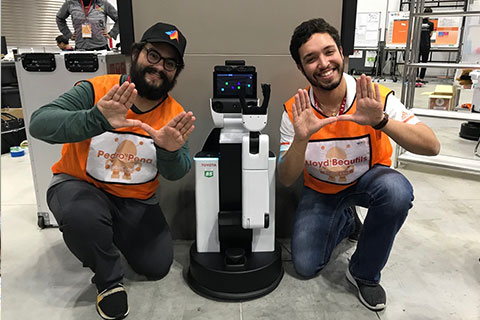Imagine a future where a robot could clean the room after a child forgot to pick up their toys. Or if an elderly man was too weak to walk, he could ask the robot to get his medication, and it would return moments later with the bottle.
This is not so far off, say members of RoboCanes, the University of Miami’s robotics team, especially with the new hardware in Toyota’s Human Support Robot. Recently, the team received their own model from Toyota to use for three years. The arrangement with UM, and other robotics teams around the world, is that students will use the robot for research that could help Japan’s aging population who have fewer children than in the past, and therefore need more caretakers.
“We must do research with [the robot] to provide solutions, so that they can tackle the issues of people living alone in the future,” said graduate Computer Science student and team member Lloyd Beaufils.
Although they have only had the new robot since last spring, the RoboCanes team has been pretty successful at developing software for their robot, named Palpatine (an ode to the “Star Wars” character). They have been so effective that RoboCanes recently became the only U.S. team to place in the finals at the World Robot Summit in Tokyo, Japan, where they placed 6th, and tied with Mexico’s PUMAS team, ranked second in the world, said the team’s adviser, Computer Science Professor Ubbo Visser.
“The world is evolving and there are more challenges coming,” Visser said. “This is a different challenge where we got the opportunity to [work with] one of the finest robots on the market.”
The new robot represents a shift from the past, when the RoboCanes entered competitions where their Softbank Robotics Nao robots faced off against another team in robot soccer matches. At the most recent competition, the RoboCanes@Home team entered in the service category and focused on a “Bring Me” task, where the robot had to independently locate and retrieve objects that were randomly chosen by judges and deliver them to a RoboCanes team member.
The World Robot Summit is funded by the Japanese government to help find solutions to problems humans face. Such issues range from performing rescue operations after natural disasters, to providing physical assistance to the elderly or the infirmed. Due to this sponsorship, RoboCanes’ competitors were mostly larger teams with 8 to 10 members from Japan because their travel costs are lower. However, RoboCanes could only send two team members to Japan — graduate student Pedro Peña and Beaufils. Team members Michael Davis, a Computer Science junior, and Joseph Masterjohn, a graduate Computer Science student, supported them by working in the lab at UM, and uploading information to update the team’s software programs in time for the next day of competition.
The pace is grueling, members say. To prepare the robot for these tasks, the team must constantly update previously prepared software on the spot. This helps the robot react to obstacles in the competition space that require it to change course.
“Robots have ad hoc data they get through a camera, but they don’t know if for example, a piece of furniture has been moved,” Visser said. “Social conventions are things that we have as humans because we have been trained, but computers do not.”
Therefore, at every competition, the team must train the robot to perform a task given by the judges. First, team members program the robot to create a map of the room where the task must be done. Next, group members must photograph every object that the robot may have to pick up at a variety of angles, so the robot can create a 3D image of the item. In Tokyo, there were 50 items the robot could have to pick up, so this process took the longest, team members said. The third step is called “motion planning,” where the robot learns how to grasp an object based on the position of the object and its own location. Finally, the group must create a behavior planner “agent” that helps the robot decide how to act based on its surroundings, such as where to go after it retrieves an object.
“To make [the agent] really robust and adaptable to unforeseen situations is a difficult task to accomplish,” Peña said.
Yet, because the team worked to perfect their agent before the trip, they were able to design one that could troubleshoot problems and try again, if needed. This helped the RoboCanes edge past their competitors, Beaufils said.

Though the competition is intense, and members return sleep deprived, all of the RoboCanes say they have fun while learning tools that can help shape the future. Former RoboCanes members have gone on to work at Google Brain, where new products are developed, as well as Volkswagen, and other businesses that are developing self-driving vehicles. All of these companies are investing in robots that can help improve their businesses and products, team members say.
“A lot of what we are doing is specific to this competition, but it’s applicable to a range of fields, so the skills we are learning can translate to entirely different industries,” Beaufils said.
Their next competition? RoboCup 2019 in Sydney, Australia this summer, and team members are already preparing their audition video.

